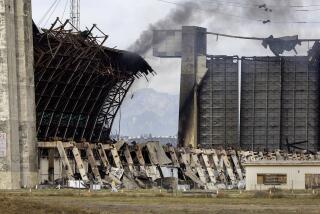ASIA : Quake Survivors Face Hazard in Rebuilding Kobe: Asbestos
- Share via
KOBE, Japan — As demolition crews begin razing hundreds of buildings damaged by Japan’s recent killer earthquake, they are releasing more than dust and debris into the air. Abnormally high levels of asbestos, which can cause afflictions from labored breathing to lung cancer, have been detected in and around this port city in western Japan.
The Environmental Agency found asbestos levels 5 1/2 times higher than normal--an average of 0.8 fibers per liter of air compared to normal readings of 0.14 fibers per liter--in readings taken at 50 locations around Kobe and nearby Nishinomiya last month. At demolition sites, levels were 14 times higher, 11.2 fibers per liter of air, than the average at other locations, and independent environmental groups registered readings as high as 250 fibers per liter of air in some areas.
Once called the “magic mineral” for its strength, versatility and insulating qualities, asbestos was widely used to fireproof and soundproof buildings in Japan as well as in the United States. It was later found that asbestos, while harmless when left intact inside walls, releases lung-scarring fibers when broken up and allowed to drift into the air.
More than 100,000 asbestos lawsuits remain pending in the United States, which has banned its use; 350,000 people will develop fatal cancer, and 1 million more will suffer from non-malignant diseases, according to studies performed at Mt. Sinai Hospital in New York.
Such dangers prompted Japan to outlaw the use of asbestos about 10 years ago. But the nation has not acted aggressively to remove the fibers from older buildings--at least 400 of which are now under the wrecker’s ball in Kobe, officials say.
Experts, however, disagree on the health threat posed by the airborne fibers. Fumiya Iwamoto, an environmental official with Hyogo prefecture, said the pollution law allows levels of up to 10 fibers per liter of air and that the difference between 10 and the recently registered 11.2 could be considered a “measurement error.”
But Hikozaburo Yoda, an environmental activist and Tokyo University engineering instructor, said officials were whitewashing the problem in order to rapidly rebuild the city. He claimed that officials had privately acknowledged to him that the health of Kobe residents in 10 years will be significantly worse than it is today because of asbestos.
Still, Kobe officials agree the abnormally high levels of asbestos require protective steps, and they have alerted 1,400 demolition firms to take special measures: wrap the building in plastic sheeting, spray the rubble with water to keep the fibers from getting into the air and bury the debris in protective wrap.
But Yoda and others say few firms are following such elaborate safety procedures because they believe that speed is of the essence. And city officials say they do not have the time or staff to inspect the demolition sites.
But local activists have called on citizens to protect themselves by wearing masks; the Asbestos Extermination Network recently used part of a $225,000 corporate donation to buy masks for Kobe schoolchildren.
Not everyone, however, is aware of the threat. One taxi driver, warning of the abnormally high asbestos levels in the air, advised passengers to wear masks and keep car windows closed.
Researcher Chiaki Kitada of the Times Tokyo Bureau contributed to this report.
(BEGIN TEXT OF INFOBOX / INFOGRAPHIC)
About Asbestos
Prized for its strength, versatility and insulating qualities, asbestos was once widely used to fireproof and soundproof buildings. Harmless when left intact, asbestos releases lung-scarring fibers when broken up and allowed to drift into the air.
Asbestos levels at Kobe (fibers per liter of air) Normal: 0.14 Since quake: 0.8 Demolition sites: 11.2 Source: Japan’s Environmental Agency
More to Read
Sign up for Essential California
The most important California stories and recommendations in your inbox every morning.
You may occasionally receive promotional content from the Los Angeles Times.














